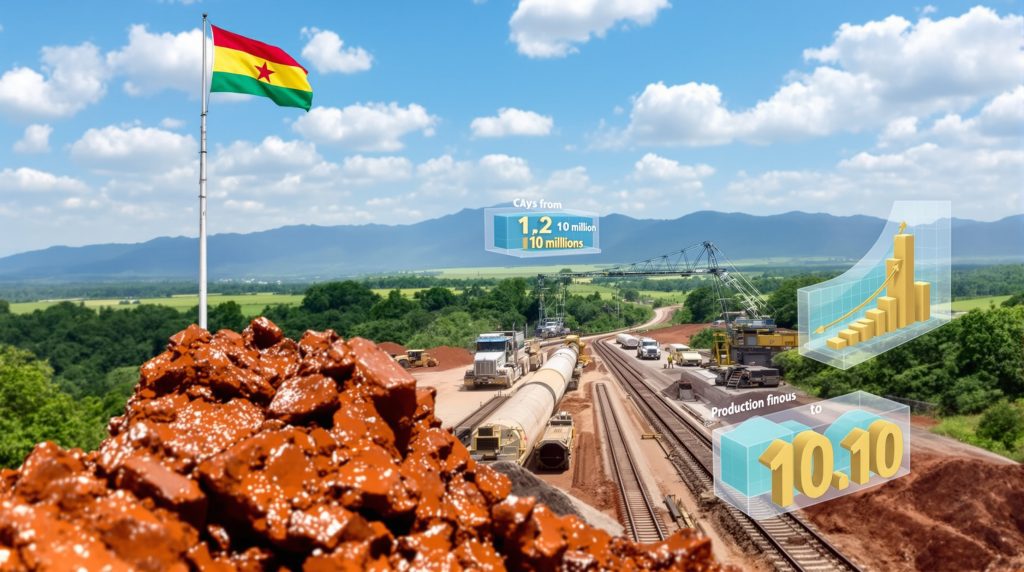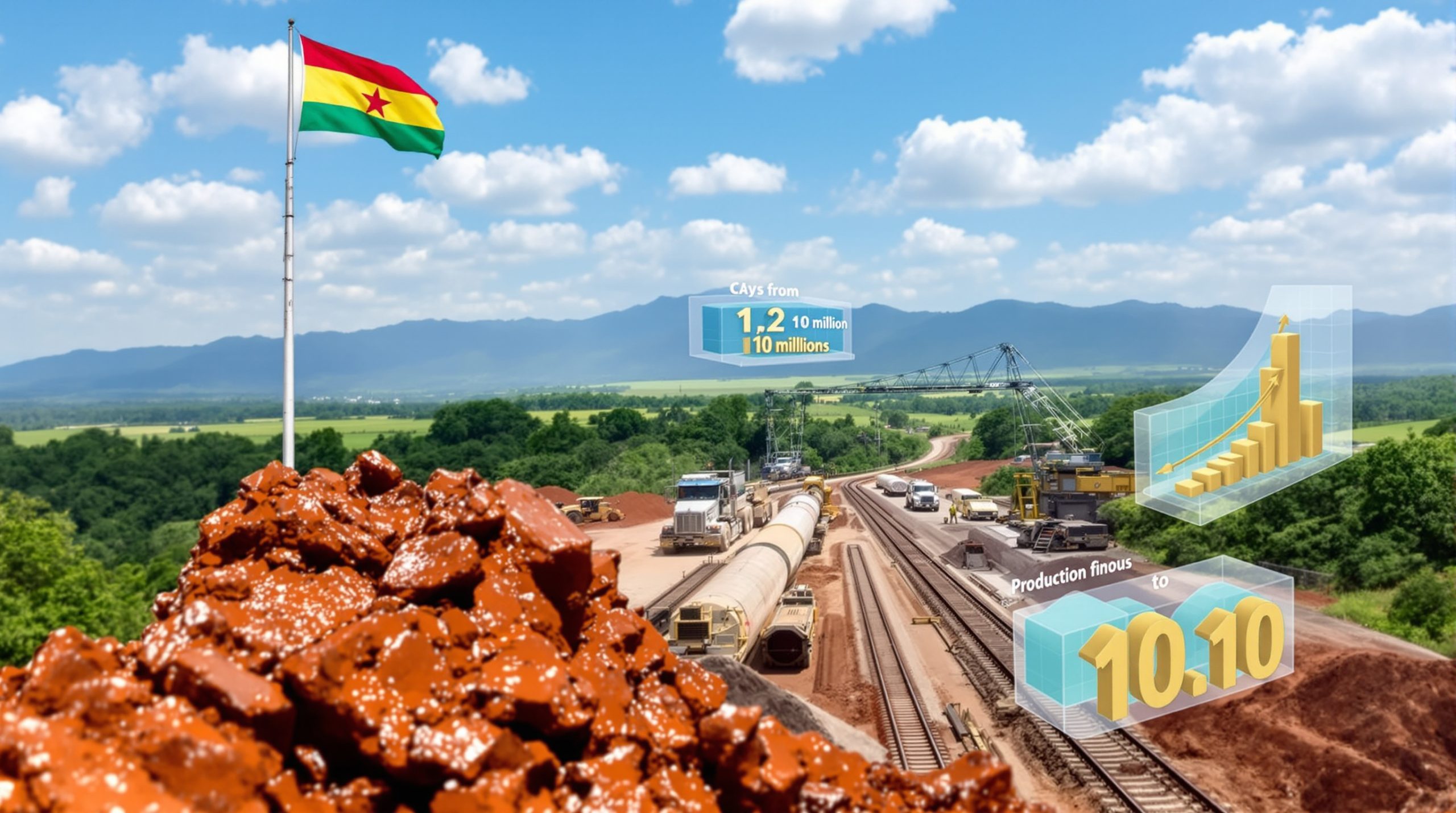Pioneering Bauxite Production in Cameroon: The Minim Martap Project
Canyon Resources is set to make history as it prepares to launch Cameroon's first bauxite mine. The Minim Martap project represents a significant milestone for both the company and the country, with production scheduled to begin in January 2026. This ambitious undertaking promises to transform Cameroon's mining sector while contributing to global aluminum supply chains.
What is the Minim Martap Bauxite Project?
The Minim Martap project stands as a groundbreaking development in Cameroon's resource sector. Located in the central region of the country, this high-grade bauxite deposit is strategically positioned to become a major player in the global bauxite market. Australian mining company Canyon Resources has committed to developing this resource, with initial production set to commence in January 2026.
Project Overview and Location
Situated in central Cameroon, the Minim Martap bauxite deposit enjoys a strategic location near the country's main rail corridor that connects to the Atlantic port of Douala. This proximity to existing transportation infrastructure provides crucial logistical advantages for the export-oriented operation.
Unlike many mining projects that require extensive infrastructure development in remote locations, Minim Martap's position near established rail networks significantly reduces capital expenditure requirements. This strategic advantage allows Canyon Resources to allocate more resources toward optimizing extraction and processing operations rather than building transportation systems from scratch.
Geological Significance
The Minim Martap deposit features exceptionally high-grade bauxite resources, placing it among the world's premium bauxite reserves. Geological assessments indicate that the ore quality surpasses many competing deposits globally, with favorable chemical compositions that make it particularly valuable for aluminum production.
The deposit's composition includes low silica content and high alumina percentages, characteristics highly prized by aluminum refineries. These superior geological attributes position the project as a potentially significant contributor to global aluminum supply chains, particularly as manufacturers seek higher-grade inputs for more efficient production processes.
How Will Canyon Resources Develop Cameroon's First Bauxite Mine?
Canyon Resources has outlined a comprehensive development plan for the Minim Martap project, combining strategic investment with a phased expansion approach. This methodical development strategy allows for initial production while building toward much larger operational capacity over time.
Initial Investment and Production Timeline
Canyon Resources has committed US$96 million for the initial development phase of the Minim Martap project. This investment will fund the necessary infrastructure, equipment, and operational setup to launch mining operations by January 2026.
The company's approach begins with a modest production target of 1.2 million tons annually during the first phase. This conservative starting point allows Canyon to establish operational protocols, refine extraction methodologies, and build market relationships before scaling to higher production volumes.
This initial phase represents just the beginning of a more ambitious development plan that will see production capacity expand significantly over the following years, positioning Cameroon as an increasingly important player in global bauxite markets.
Financing Structure
The project's financial backing incorporates a diverse mix of funding sources, providing a solid foundation for both initial development and future expansion:
| Funding Source | Amount | Purpose |
|---|---|---|
| AFG Bank Cameroon facility | US$140 million | Primary development funding |
| Equity raising | A$25.4 million (US$16.5 million) | Supporting capital |
| Eagle Eye Asset Holdings | Major shareholder support | Long-term financial backing |
Secured in May 2025, the US$140 million facility from AFG Bank Cameroon forms the cornerstone of the project's financial structure. This is complemented by A$25.4 million (approximately US$16.5 million) raised through equity, with significant backing from major shareholder Eagle Eye Asset Holdings.
The total projected investment over the life of the project is expected to reach US$446 million, supporting the mine planning process and infrastructure development across its operational lifespan. This substantial financial commitment reflects confidence in both the geological quality of the deposit and the economic viability of its extraction.
Production Expansion Plans
The definitive feasibility study released on September 1, 2025, outlines an ambitious growth trajectory for the Minim Martap project:
- 2026: Initial production of 1.2 million tons per year
- By 2032: Expanded production reaching 10 million tons annually
This projected expansion represents a significant increase from earlier estimates of 6.4 million tons annually outlined in Canyon's 2022 feasibility study. The upward revision demonstrates growing confidence in the project's potential based on updated geological assessments and market forecasts.
The phased expansion approach allows Canyon Resources to manage capital expenditure efficiently while gradually scaling operations in response to market demand and operational experience. This strategy reduces initial financial risk while maintaining the flexibility to accelerate development as conditions warrant.
What Infrastructure Will Support the Minim Martap Project?
Infrastructure development forms a critical component of the Minim Martap project plan. Canyon Resources has designed an integrated transportation and logistics system that leverages existing infrastructure while developing new capabilities to support mining operations.
The Makor Inland Rail Facility
A cornerstone of the Minim Martap development is the construction of the Makor Inland Rail Facility. This dedicated rail hub will serve as the critical link between the mine site and Cameroon's existing rail network, facilitating efficient transport of bauxite to export terminals.
Construction of this vital infrastructure component began in 2025, with completion scheduled before production commences in January 2026. The facility will include loading equipment, storage areas, and rail connections designed specifically for handling high volumes of bauxite ore.
The rail facility's design incorporates modern materials handling technology to minimize dust generation and product loss during transfer operations. This attention to environmental considerations reflects Canyon's commitment to sustainable mining practices throughout the project lifecycle.
Transportation and Logistics
The project's logistics strategy leverages Cameroon's existing rail infrastructure to transport bauxite from the mine to coastal export facilities. This approach minimizes upfront capital requirements while ensuring reliable product delivery to international markets.
Canyon has secured necessary agreements with Cameroon's rail authorities to guarantee access to the national rail network for bauxite transportation. These agreements include capacity allocations sufficient to support both initial production volumes and future expansion plans.
The integrated transportation system will connect the mine site to port facilities capable of accommodating vessels suited for international bauxite shipping. This comprehensive logistics approach ensures the project can reliably deliver product to global markets while maintaining competitive cost structures.
What Economic Benefits Will the Project Bring to Cameroon?
The Minim Martap project represents a significant economic opportunity for Cameroon, offering multiple avenues for national benefit from resource development. Beyond direct revenue generation, the project will create employment, develop infrastructure, and potentially catalyze further investment in the country's mining sector.
Government Participation and Revenue
Under the mining convention signed with Canyon Resources in July 2024, the Cameroonian government will receive substantial economic benefits from the project:
- A free 10% stake in the Minim Martap project
- A 5% royalty on all project revenues
This structure ensures the nation benefits directly from its mineral resources while maintaining an attractive investment environment for project developers. The government's equity position provides participation in project governance and future profitability beyond basic royalty revenue.
The royalty mechanism ensures Cameroon receives revenue from the first shipment, regardless of the project's profitability status. This provides immediate economic returns while the equity stake offers long-term value appreciation as the project develops and expands.
Project Lifespan and Long-term Impact
With a projected operational lifespan of 20 years, the Minim Martap project represents a long-term economic asset for Cameroon. This extended timeframe provides sustainable economic benefits and allows for comprehensive planning of associated development initiatives.
Beyond direct revenue generation, the project will create significant employment opportunities for Cameroonians. Initial hiring will focus on construction and development roles, transitioning to operational positions as production begins. The project will require a diverse workforce spanning technical, administrative, and support functions.
The development of local infrastructure to support mining operations will have spillover benefits for surrounding communities. Improvements to transportation networks, power distribution, and communications systems will enhance regional connectivity and economic activity beyond the mining sector.
As Cameroon's first bauxite mine, Minim Martap may serve as a catalyst for additional mining investment in the country. Successful development of this project demonstrates Cameroon's viability as a mining jurisdiction and could attract further exploration and development activity across various mineral resources.
How Does Minim Martap Compare to Other African Bauxite Projects?
The development of Minim Martap positions Cameroon to join established West African bauxite producers. Understanding how this project compares to regional competitors provides important context for its potential impact on both Cameroon's economy and global bauxite markets.
Regional Context
The development of Minim Martap positions Cameroon to join established West African bauxite producers like Guinea, which currently dominates the region's production. Guinea has established itself as a global bauxite project benefits powerhouse, with multiple large-scale operations supplying international markets.
Cameroon's entry into bauxite mining diversifies the regional supply landscape and creates healthy competition in the sector. This diversification benefits both producing countries and global consumers by reducing concentration risk and potentially improving market efficiency.
The development timing coincides with growing global demand for bauxite, particularly driven by expanding aluminum production capacity in Asia. This favorable market environment provides opportunities for new producers like Cameroon to establish market position without directly competing with established operations for market share.
Competitive Advantages
Several factors distinguish the Minim Martap project within the competitive landscape of African bauxite mining:
- Exceptional ore quality compared to many existing operations, with chemical properties that make it particularly valuable for aluminum production
- Proximity to existing transportation infrastructure, reducing capital requirements and improving logistics efficiency
- Strong government support and partnership through the mining convention structure
- Phased development approach minimizing initial capital requirements while maintaining expansion flexibility
These advantages position the project favorably within the competitive landscape of African bauxite mining. The combination of resource quality and strategic location creates a sustainable competitive position that can support long-term operational success.
Unlike some competing projects that require extensive infrastructure development in remote locations, Minim Martap's location advantages allow for more efficient capital allocation toward operational excellence rather than supporting infrastructure.
What Challenges Must Canyon Resources Navigate?
Despite its promising attributes, the Minim Martap project faces several significant challenges that Canyon Resources must address to ensure successful development and operation. Understanding these challenges provides important context for evaluating the project's risk profile and management approach.
Funding the Expansion Phase
While initial production funding is secured, Canyon Resources has not yet detailed how it will finance the additional capital expenditure required to reach the 10 million ton annual production target. This financing gap represents a significant challenge that management must address in coming years.
Potential funding sources for expansion could include additional debt facilities, equity raises, joint venture partnerships, or streaming arrangements. Each approach carries different implications for ownership structure, financial returns, and operational control that must be carefully evaluated.
The company's ability to demonstrate operational success during the initial production phase will significantly impact financing options for expansion. Establishing a track record of reliable production, cost control, and product quality will strengthen Canyon's position when seeking additional capital.
Offtake Agreements
Canyon plans to negotiate offtake agreements by the end of 2025 to secure buyers for the mine's initial production. These agreements will be crucial for project bankability and ensuring stable revenue streams once production begins.
Successful offtake negotiations require balancing price security against flexibility to capture market upside. Long-term agreements provide revenue stability but may limit opportunities to benefit from favorable market conditions. Conversely, excessive spot market exposure creates revenue uncertainty that can complicate financial planning.
The quality characteristics of Minim Martap bauxite will influence offtake negotiations, potentially allowing Canyon to secure premium pricing for higher-grade material. Effectively communicating these quality advantages to potential buyers will be essential for maximizing value through offtake arrangements.
Infrastructure Development
Timely completion of the Makor Inland Rail Facility and coordination with Cameroon's existing rail and port infrastructure presents logistical challenges that must be carefully managed to avoid production delays.
The project relies on integrating new and existing infrastructure components into a seamless logistics chain. Coordination between multiple stakeholders, including government agencies, rail operators, and port authorities, requires effective relationship management and clear communication protocols.
Construction scheduling must account for potential delays due to weather conditions, equipment availability, or regulatory processes. Contingency planning for infrastructure completion will be essential to mitigate risks to the production timeline.
What is the Global Significance of the Minim Martap Project?
Beyond its importance to Cameroon and Canyon Resources, the Minim Martap project holds broader significance for global bauxite and aluminum markets. As a new, high-quality supply source, the project contributes to market dynamics that influence global industrial development.
Aluminum Supply Chain Implications
Bauxite is the primary ore for aluminum production, a metal critical to multiple industries including:
- Aerospace and defense: Lightweight structural components and specialized alloys
- Automotive manufacturing: Vehicle weight reduction for fuel efficiency and performance
- Construction: Building systems, facades, and structural elements
- Renewable energy infrastructure: Solar mounting systems and wind turbine components
- Consumer electronics: Device casings and internal components
The Minim Martap project will contribute to global aluminum supply security at a time when demand continues to grow across these sectors. As industries increasingly prioritize lightweight materials for efficiency and performance, aluminum demand is projected to maintain strong growth trajectories.
The project's high-grade ore can support production of premium aluminum products, potentially addressing specific market segments that require superior input materials. This quality advantage positions Minim Martap to serve specialized market niches beyond basic commodity supply.
Diversification of Global Bauxite Sources
The project represents an important diversification of global bauxite supply, which is currently dominated by Australia, Guinea, and China. New sources like Cameroon help reduce supply concentration risk in critical mineral supply chains.
Geopolitical considerations increasingly influence mineral supply strategies as nations and manufacturers seek to reduce dependency on limited source regions. Cameroon's emergence as a bauxite producer provides an additional option for supply diversification planning.
The development timing coincides with growing emphasis on responsible sourcing and supply chain transparency. Establishing new operations with modern environmental and social governance standards responds to market demand for responsibly produced materials.
What's Next for Canyon Resources and Minim Martap?
As Canyon Resources progresses toward production at Minim Martap, several key milestones and strategic priorities will shape the project's development trajectory. Understanding these forward-looking elements provides insight into both near-term catalysts and long-range potential.
Near-term Milestones
Key upcoming project milestones include:
- Completion of the Makor Inland Rail Facility construction
- Finalization of offtake agreements by end of 2025
- Commencement of production in January 2026
- First export shipments in Q1 2026
These milestones represent critical validation points for the project development strategy. Successful achievement of each target will build confidence in management execution capability and project viability.
The transition from development to operational status in early 2026 marks a fundamental shift in project focus from construction to production optimization. This transition requires different skill sets and management approaches as the organization evolves from building to operating the mine.
Initial production performance will establish baseline metrics for efficiency, product quality, and operational reliability that will influence subsequent expansion planning and implementation strategies.
Long-term Development Strategy
Beyond initial production, Canyon Resources will focus on:
- Optimizing operational efficiency to maximize returns from the initial production capacity
- Securing funding for production expansion toward the 10 million ton annual target
- Potentially developing downstream processing capabilities to capture additional value
- Exploring additional resource development opportunities in the region
Operational optimization during the initial production phase will establish cost structures and efficiency benchmarks that inform expansion planning. Continuous improvement processes will target extraction methodologies, logistics coordination, and maintenance practices to maximize operational performance.
Expansion funding strategies will likely evolve based on initial production experience and prevailing market conditions. Successful operation at the initial scale will strengthen Canyon's position when seeking additional capital for expansion phases.
The company may explore opportunities for downstream integration into alumina refining or other processing activities as the project matures. Such vertical integration could capture additional value from the bauxite resource while diversifying revenue streams.
Frequently Asked Questions: Canyon Resources' Minim Martap Bauxite Project
When will the Minim Martap project begin producing bauxite?
Production is scheduled to commence in January 2026, starting with 1.2 million tons annually.
How much is Canyon Resources investing in the project?
The initial investment is US$96 million, with total project investment expected to reach US$446 million over its lifespan.
What is the projected production capacity?
Starting at 1.2 million tons per year in 2026, production is expected to increase to 10 million tons annually by 2032.
How will the bauxite be transported from the mine?
The ore will be transported via the Makor Inland Rail Facility connecting to Cameroon's existing rail network to reach coastal export terminals.
What benefits will Cameroon receive from the project?
Cameroon will receive a 10% free stake in the project and a 5% royalty on all revenues, along with employment opportunities and infrastructure development.
The Future of Bauxite Mining in Cameroon
The Minim Martap project represents just the beginning of potential bauxite development in Cameroon. The country's geological formations suggest additional deposits may exist that could support future mining operations beyond the current project scope.
As Canyon Resources establishes operational presence in Cameroon, knowledge transfer and capacity building will develop local expertise in bauxite mining. This emerging capability creates foundation for sustainable industry trends & innovation beyond the initial project.
The global transition toward renewable energy and electrification suggests long-term demand growth for aluminum, supporting favorable market conditions for new bauxite producers. Cameroon's entry into this market through the Minim Martap project positions the country to benefit from these macro trends.
Furthermore, the success of the Niagara bauxite project demonstrates growing interest in bauxite development across Africa. This regional momentum creates opportunities for knowledge sharing and potential collaboration as Cameroon develops its own bauxite sector.
For investors interested in the mining sector, Canyon Resources' Minim Martap project represents one of several compelling investment opportunities in the African resources landscape. The combination of high-grade deposits, strategic infrastructure advantages, and strong government support creates a promising foundation for long-term value creation.
Disclaimer: This article contains forward-looking statements regarding production timelines, expansion plans, and market projections. Actual outcomes may differ from these projections due to various factors including market conditions, operational challenges, regulatory developments, or other unforeseen circumstances. Readers should consider these statements as projections rather than guarantees of future performance.
Looking to Capitalise on the Next Major Mineral Discovery?
Stay ahead of the market with Discovery Alert's proprietary Discovery IQ model that instantly identifies significant ASX mineral discoveries and transforms complex data into actionable insights. Explore historic examples of exceptional market returns on our dedicated discoveries page and begin your 30-day free trial today.




